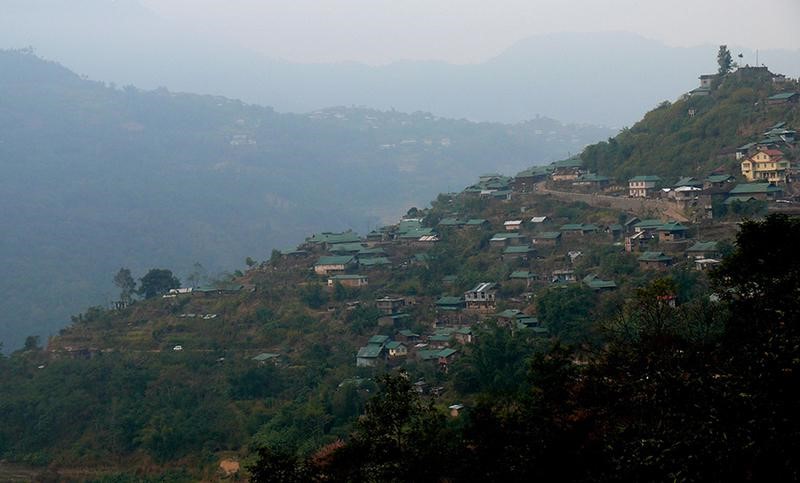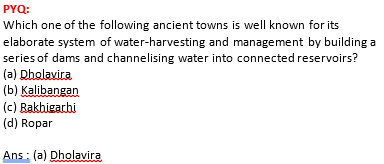
Disclaimer: Copyright infringement not intended.
Context: The Ladpura Khas village of Madhya Pradesh, Khonoma village of Nagaland and heritage sites like Dholavira will be showcased as success stories of rural and archaeological tourism by India during the first tourism working group meeting of the G-20 nations to be held at the Rann of Kutch.
Details:
- Rural tourism and archaeological tourism will be the topics for two side events at the first tourism ministerial meeting of the G-20 from February 7 to 9 where India will highlight the most successful and innovative initiatives of these from various parts of India.
- Ladpura Khas was nominated as the Best Rural Tourism Village by the UNWTO.
- India will also present the innovative model of community based Astrotourism that involves rural homestays and community spaces that are completely run by villagers and provides travellers an integrated experience of stargazing along with cultural immersion in the Himalayas.
- Nagaland’s Khonoma Village will present the model of Ecotourism Management Board that develops Rural Tourism Products and promotes responsible travel.
LADPURA KHAS VILLAGE-‘BEST TOURISM VILLAGE’:
- Three Indian villages were nominated for UNWTO’s ‘Best Tourism Village’.
- Madhya Pradesh's Ladpura Khas village, Meghalaya's Kongthong village, and Telangana's Pochampally are the villages that have been nominated.
Ladpura Khas village:
- It is located in Tikamgarh district in Madhya Pradesh.
- It is famous for its palaces and temples built in the 16th and 17th centuries.
Kongthong village:
- It is also known as 'Whistling village' as in this village, a mother calls her child by a tune instead of a name, like Eeooow, Ooeeo, etc.
- These musical names are called ‘jingrwai Iawbei.’
- The villagers here have two names-a regular name and a song name.
- The song names have two versions, a short song (used at home) and a long song (used in the forest to keep away evil spirits).
Bhoodan Pochampally village:
- Bhoodan Pochampally village located in Yadadri Bhuvanagiri district of Telangana is popular for its weaves, especially handwoven ikkat saris.
- It is known for its famous Bhoodan movement, which saw rich landowners voluntarily gift a percentage of their lands to the landless.
.jpeg)
KHONOMA VILLAGE:
- 20 Kilometers away from the busy streets of Nagaland’s state capital is Khonoma village, overlooking mesmerizing paddy fields and hills covered with lush forests
- Often described as a ‘warrior village’, Khonoma is known for its fierce resistance during the British colonial period.
- Apart from that, Khonoma is also known for its initiatives in wildlife conservation.
- In 1998, the Khonoma Nature Conservation and Tragopan Sanctuary (KNCTS) was set up to protect the endangered Blyth’s Tragopan and other wildlife and rare plant species in their natural habitat.
-
Over the last two decades, bird enthusiasts from around the world have come to Khonoma just to spend their days listening to the call of the birds and watching them.
-
Khonoma is also the first Green Village in Asia. With its naturally blessed resources, intriguing history and rich culture, the village is one of the most visited places in Nagaland
DHOLAVIRA:
- Dholavira is an example of a proto-historic Bronze Age urban settlement pertaining to the Harappan Civilization.
- It bears evidence of a multi-cultural and stratified society during the 3rd and 2nd millennia BCE.
- It is the first site of the ancient Indus Valley Civilisation (IVC) in India to get the tag.
- Dholavira and the Ramappa Temple were included in the list during the 44th session of the UNESCO’s World Heritage
Distinct features of Dholavira:
- After Mohen-jo-Daro, Ganweriwala and Harappa in Pakistan and Rakhigarhi in Haryana of India, Dholavira is the fifth largest metropolis of IVC.
- The site has a fortified citadel, a middle town and a lower town with walls made of sandstone or limestone instead of mud bricks in many other Harappan sites.
- A series of water reservoirs, outer fortification, two multi-purpose grounds, nine gates with unique designs, hemispherical structures like the Buddhist Stupas— as some of the unique features of the Dholavira site.
- Dholavira cites the origin of the Buddhist Stupas.
- Unlike graves at other IVC sites, no mortal remains of humans have been discovered at Dholavira.
- Remains of a copper smelter indicate of Harappans, who lived in Dholavira, knew metallurgy.
- Traders of Dholavira used to source copper ore from present-day Rajasthan and Oman and UAE and export finished products.
- It was also a hub of manufacturing jewellery made of shells and semi-precious stones,like agate and used to export timber.
- Beads peculiar to the Harappan workmanship have been found in the royal graves of Mesopotamia, indicating Dholavira used to trade with the Mesopotamians.
RURAL TOURISM:
About:
- UNWTO understands Rural Tourism as "a type of tourism activity in which the visitor’s experience is related to a wide range of products generally linked to nature-based activities, agriculture, rural lifestyle / culture, angling and sightseeing.
- Rural Tourism activities take place in non-urban (rural) areas with the following characteristics: i) low population density, ii) landscape and land-use dominated by agriculture and forestry and iii) traditional social structure and lifestyle".
Importance: Rural tourism has a high potential to stimulate local economic growth and social change because of its complementarity with other economic activities, its contribution to GDP and job creation, and its capacity to promote the dispersal of demand in time (fight seasonality) and along a wider territory.

ARCHAEOTOURISM:
About: Also known as Archaeological tourism, it is a form of cultural tourism, which aims to promote public interest in archaeology and the conservation of historical sites.
BEST TOURISM VILLAGES BY UNWTO:
- With the vision of making tourism a positive force for transformation, rural development and community wellbeing, UNWTO launched the ‘Best Tourism Villages by UNWTO’
- It seeks to advance the role of tourism in valuing and safeguarding rural villages along with their associated landscapes, knowledge systems, biological and cultural diversity, local values and activities (agriculture, forestry, livestock and/or fisheries), including their gastronomy.
UNWTO:
- The World Tourism Organization (UNWTO) is the United Nations agency responsible for the promotion of responsible, sustainable and universally accessible tourism.
- As the leading international organization in the field of tourism, UNWTO promotes tourism as a driver of economic growth, inclusive development and environmental sustainability and offers leadership and support to the sector in advancing knowledge and tourism policies worldwide.
Our Priorities:
- Mainstreaming tourism in the global agenda: Advocating the value of tourism as a driver of socio-economic growth and development, its inclusion as a priority in national and international policies and the need to create a level playing field for the sector to develop and prosper.
- Promoting sustainable tourism development: Supporting sustainable tourism policies and practices: policies which make optimal use of environmental resources, respect the socio-cultural authenticity of host communities and provide socio-economic benefits for all.
- Fostering knowledge, education and capacity building: Supporting countries to assess and address their needs in education and training, as well as providing networks for knowledge creation and exchange.
- Improving tourism competitiveness: Improving UNWTO Members’ competitiveness through knowledge creation and exchange, human resources development and the promotion of excellence in areas such as policy planning, statistics and market trends, sustainable tourism development, marketing and promotion, product development and risk and crisis management.
- Advancing tourism’s contribution to poverty reduction and development: Maximizing the contribution of tourism to poverty reduction and achieving the SDGs by making tourism work as a tool for development and promoting the inclusion of tourism in the development agenda.
- Building partnerships: Engaging with the private sector, regional and local tourism organizations, academia and research institutions, civil society and the UN system to build a more sustainable, responsible and competitive tourism sector.
Members: An intergovernmental organization, UNWTO has 160 Member States, 6 Associate Members, 2 Observers and over 500 Affiliate Members.
Organs:
- The General Assembly is the supreme organ of the Organization.
- The Executive Council take all measures, in consultation with the Secretary-General, for the implementation of the decisions and recommendations of the General Assembly and reports to the Assembly.
Secretariat:
- UNWTO headquarters are based in Madrid, Spain.
- The Secretariat is led by the Secretary-General and organized into departments covering issues such as sustainability, education, tourism trends and marketing, sustainable development, statistics and the Tourism Satellite Account (TSA), destination management, ethics and risk and crisis management.
- The Technical Cooperation and Silk Road Department carries out development projects in over 100 countries worldwide, while the Regional Departments for Africa, the Americas, Asia and the Pacific, Europe and the Middle East serve as the link between UNWTO and its 160 Member States.
- The Affiliate Members Department represents UNWTO’s 500 plus Affiliate members.


https://epaper.thehindu.com/ccidist-ws/th/th_delhi/issues/23712/OPS/GGQAR80JA.1+GTOAR8N4Q.1.html





.jpeg)
